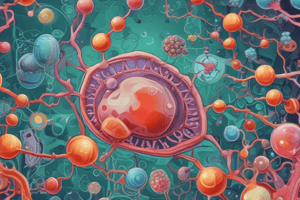Podcast
Questions and Answers
What is the primary role of the cell wall in prokaryotic cells?
What is the primary role of the cell wall in prokaryotic cells?
- Regulates the movement of substances
- Acts as a barrier against mechanical injury (correct)
- Stores hereditary information
- Synthesizes proteins
Which of the following is a characteristic unique to eukaryotic cells?
Which of the following is a characteristic unique to eukaryotic cells?
- Circular DNA
- Presence of ribosomes
- Presence of a nucleus (correct)
- Single-celled organisms
Which structure is responsible for ATP synthesis in eukaryotic cells?
Which structure is responsible for ATP synthesis in eukaryotic cells?
- Ribosomes
- Endoplasmic reticulum
- Mitochondria (correct)
- Golgi apparatus
What is the function of the rough endoplasmic reticulum (RER)?
What is the function of the rough endoplasmic reticulum (RER)?
How does the nucleoplasm function within a eukaryotic cell?
How does the nucleoplasm function within a eukaryotic cell?
Which of the following structures is involved in the packaging and distribution of proteins and lipids?
Which of the following structures is involved in the packaging and distribution of proteins and lipids?
What is a defining feature of prokaryotic cells?
What is a defining feature of prokaryotic cells?
Which organelle is responsible for detoxifying peroxides in a eukaryotic cell?
Which organelle is responsible for detoxifying peroxides in a eukaryotic cell?
What is the function of the plasma membrane in both prokaryotic and eukaryotic cells?
What is the function of the plasma membrane in both prokaryotic and eukaryotic cells?
Which component of the eukaryotic cell is primarily involved in the synthesis of membrane proteins?
Which component of the eukaryotic cell is primarily involved in the synthesis of membrane proteins?
What characteristic of life refers to an organism's ability to maintain constant internal conditions?
What characteristic of life refers to an organism's ability to maintain constant internal conditions?
Which of the following best describes biochemistry?
Which of the following best describes biochemistry?
Which biomolecule is NOT considered a fundamental component used by all organisms?
Which biomolecule is NOT considered a fundamental component used by all organisms?
Cells can be classified into which of the following types?
Cells can be classified into which of the following types?
What is primarily responsible for the growth and development of living organisms?
What is primarily responsible for the growth and development of living organisms?
Which of the following describes the cellular organization of living organisms?
Which of the following describes the cellular organization of living organisms?
Which process is essential for living organisms to obtain and utilize energy?
Which process is essential for living organisms to obtain and utilize energy?
Which of the following is NOT a characteristic of life?
Which of the following is NOT a characteristic of life?
Flashcards are hidden until you start studying
Study Notes
Introduction to Life and Biochemistry
- Life is characterized by complexity and dynamism; all organisms comprise organic, carbon-based molecules essential for bodily processes.
- Living organisms are organized and self-sustaining, from biomolecules to organ systems.
- Cells are the basic unit of life, showing significant diversity in structure and function while playing crucial roles in chemical processes.
Characteristics of Life
- Cellular Organization: Organisms are classified as unicellular or multicellular based on cell structure.
- Homeostasis: The ability to maintain stable internal conditions (e.g., body temperature, pH, water levels).
- Metabolism: Comprises biochemical reactions that obtain and utilize energy for life processes.
- Reproduction: Entails forming offspring through sexual or asexual means.
Biochemistry Overview
- Biochemistry studies chemical processes in living organisms, serving as a multidisciplinary approach to understanding molecular life foundations.
- Applied knowledge of biochemistry is valuable in fields like medicine, environmental science, agriculture, and nutrition.
Features of Living Organisms
- Cells are highly organized and functional units critical for life.
- Biochemical reactions regulate various life processes.
Common Biomolecules
- Organisms utilize four primary types of biomolecules:
- Proteins
- Nucleic acids
- Carbohydrates
- Lipids
Cell Types
- Prokaryotic Cells:
- Small, simple structures; primarily unicellular (e.g., bacteria, archaea).
- Eukaryotic Cells:
- More complex with a nucleus; can be unicellular or multicellular (e.g., plants, protists, animals).
Prokaryotic Cell Structure and Function
- Common features include:
- Cell Wall: Provides support and shape; protects from mechanical injury.
- Plasma Membrane: Selectively permeable barrier just inside the cell wall.
- Cytoplasm: Houses the nucleoid containing circular DNA.
- Pili and Flagella: Hair-like structures aiding in locomotion and nutrient attachment.
Eukaryotic Cell Structure and Function
- Cell Membrane: A lipid bilayer offering shape, strength, protection, and permeability control.
- Cytoplasm/Cytosol: Gel-like fluid occupying most cell volume, surrounding organelles; site for energy production and cellular component manufacture.
Nucleus Characteristics
- Nucleus: Control center containing hereditary information, regulating metabolic activities.
- Nucleoplasm: Provides support for the nucleus; site for DNA and RNA synthesis.
- Nuclear Envelope: Separates nuclear components from the cytoplasm; contains nuclear pores for biomolecule passage.
- Nucleolus: Site for ribosomal RNA synthesis.
Endoplasmic Reticulum (ER)
- Rough ER (RER): Associated with membrane protein synthesis; ribosomes present on its surface.
- Smooth ER (SER): Involved in lipid synthesis and biotransformation; tubular structure.
Ribosomes and Golgi Apparatus
- Ribosomes: RNA-protein complexes formed by subunits, essential for protein synthesis.
- Golgi Apparatus: Formed by the fusion of vesicles from the ER; responsible for protein and lipid packaging and distribution.
Lysosomes and Peroxisomes
- Lysosomes: Contain enzymes to digest excess or worn-out biomolecules via endocytosis.
- Peroxisomes: Detoxify reactive oxygen species (ROS) and break down toxic molecules like peroxides.
Mitochondria
- Known as the cell's powerhouse; synthesizes ATP through carbohydrate and lipid breakdown, derived from free ribosomes.
Studying That Suits You
Use AI to generate personalized quizzes and flashcards to suit your learning preferences.




